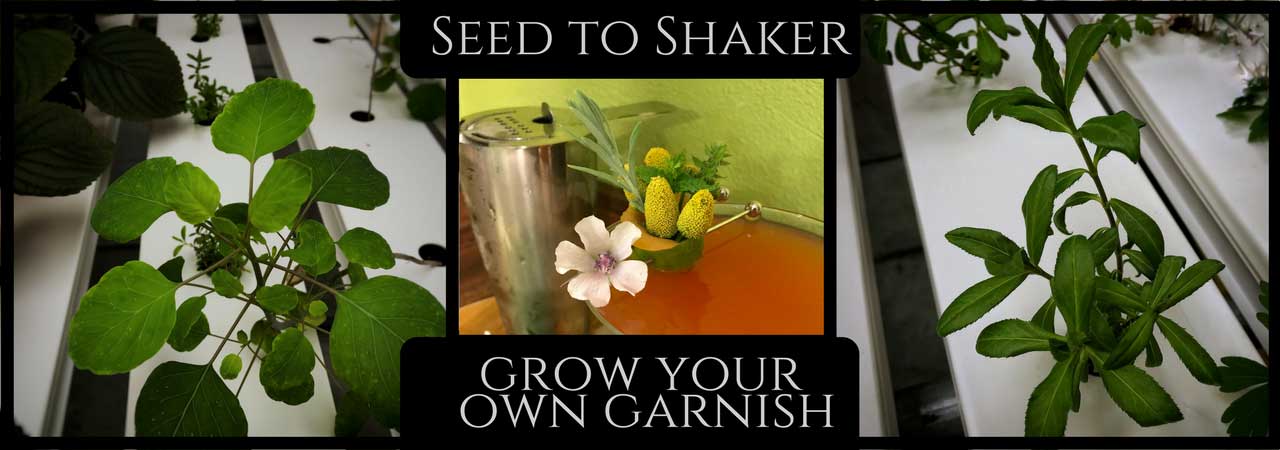Seed To Shaker: Six Unique Culinary Herbs For Exceptional Garnish
Craft Cocktails have entered a second golden age. There are more craft distilleries, opening up every day, the big boys are aging more specialty lines, and Instagram allows the sipping enthusiast as well as master mixologists a chance to explore cutting-edge creations in real time.

Editors Note: Today’s post is from Nick Burton one of the semi-finalists who are applying to become a regular contributor to Bourbon & Banter. We hope you’ll read all of their posts and let us know what you think of each applicant by commenting below the post, sharing online or dropping us a note via email.
Craft Cocktails have entered a second golden age. There are more craft distilleries, opening up every day, the big boys are aging more specialty lines, and Instagram allows the sipping enthusiast as well as master mixologists a chance to explore cutting-edge creations in real time as the best in the world push the limits of what is possible. Part of the new golden age equation is the rise of the farm to table movement.
As the leaders of hospitality develop new recipes, techniques, and showpieces, the sense of sight is what stops the thumb scroll. The cherry on top is no longer just a cherry. A broader array of props, garnish, botanical, and theatrical elements help you decide where your next liquid experience will be.
If one wanted to up the photogenic, essence, aroma, and culinary adventure of a libation using all of the resources available from the culinary world is the next natural progression.
Specialty herbs, edible flowers, and unique farm offerings that go beyond distributor options can open up a world unknown to the general public. When Chefs in the farm to table movement develop the relationships with a local farmer that facilitate exploratory collaborations, one of a kind dishes can be served to a parade of patrons demanding to be seen on the cutting edge of the new hot spot. Serving these uncommon ingredients at a home cocktail party will leave guests with cocktail envy as well.
There is no reason a bar program should look over an increasing variety of options. Let’s take a look at garnish beyond mint, citrus, and olives. No sense of using the most exceptional liquors if you are dressing with sub-par garnishes. Here are some of my favorites we grow at Paris Victory Gardens in hydroponic and soil grown operations.
SIX SPECIALTY HERBS TO ENHANCE YOUR MASTERPIECES.

PAPALO
A cilantro like leaf with a pungent kick. Even muddling this herb may release enough essence to overwhelm a drink, but a floating leaf is beautiful in its simplicity. A quick rub before placing in a drink will release enough to tickle the nose.
Pairing: Tequila based drinks.

BORAGE
This herb is a prolific bloomer of sky blue edible flowers that taste like a mellow cantaloupe. When encased in an ice mold the flower retains it’s fresh look.
Pairing: Botanically infused gin and vodka-based drinks.

MEXICAN MINT
With a flavor profile of anise crossed with mild tarragon with a lingering sharp mint aftertaste this ancient herb can also be overdone. It is a sturdy garnish and can merely be submerged along with ice or rested on a rim.
Pairing: Rum, Tequila

LEMON DROP SPILANTHES
AKA: toothache plant AKA Buzz Button. This medicinal herb has long been used to numb the mouth during times of tooth discomfort. It is a similar sensation as holding a 9-volt battery to your tongue. Aside from this bloom looking like a small lemon, biting into this button will leave your mouth numb for 5-10 minutes. It is fun to watch someone experience the sensation for the first time.
Pairing: Versatel, looks great in anything.

BASIL
There are many variants of basil to play with. Citrus, lemon, lime, licorice, cinnamon basils can range in color from lime green to dark red and purple. The single fat leafs, small new growth clusters, and flowering stems are all edible and are all beautiful to use while producing deep flavors. Muddling and prolonged ice exposure will bruise the leafs, so this herb should only be applied right before the presentation.
Pairing: If you are using Fernet, Aperol, Chartreuse, or Absinthe you are in a prime position to add a basil variety.

ORANGE THYME
As thyme has always been a staple garnish. Orange thyme with its citrus notes, sturdy stock, and the option to flame adds a new taste to an industry standard.
Pairing: The most versatile herb from this bunch, I have enjoyed the citrus & thyme notes in virtually anything shaken or stirred. This multi-use herb is a hearty grower year round, thrives in a dry environment, and is evergreen in winter. In summer pairing with local clear spirits works well as an infusion and garnish. As the temperature drops and I begin to sample bourbons and whiskeys orange time can be used in classics like Manhattans and Old Fashions as well as a stand alone addition on the rocks. My favorite: a lavender shrub with Treaty Oak’s Waterloo Gin with long sprigs of thyme from top to bottom of a Collins Glass.
WHERE TO SOURCE LOCAL SPECIALTY HERBS.
Local farms in your area may not currently grow these herbs, but most growers are eager to add streams of revenue. When cropped with the co-marketing and social benefits save growers can add through social media shares these collaborations can help both the bar and the farm.
Keep in mind it may take a few weeks to get a full harvest from seed.
Jeff Bednar of Profound Microfarms who serves the finest restaurants and award-winning chefs in the Dallas area. Such as Aaron Nelson of Hookline Plano, Jeramie Robison of City Hall Bistro at the Adolphus, Josh Sutcliff of Mirador, and Matt McCallister of FT33 grow these herbs along with a rotating selection of over 30 herbs and edible flowers.
The key to sourcing local is to work together with farmers committed to serving the finest crops, similar to the elevating Dallas Chef and Mixologist scene. “ The exciting and dynamic collaboration between farmer/Chef relationships allows both parties to create unique seasonal offerings of flavorful and fresh ingredients.
The opportunity for chefs and cocktail mixologists have the freedom to experiment with new flavor combinations. Jeff says “the farmer/chef relationship is his favorite part of running an urban farm” he builds this relationship by delivering directly to chefs and mixologists twice per week. Jeff often brings samples of new varieties he’s experimenting with, and he’ll regularly host chefs out to his farm just 30 min north of downtown where chefs can get their hands dirty helping out or just tasting any of the over 75 varieties of edibles Profound Microfarms is growing at any one giving time.

